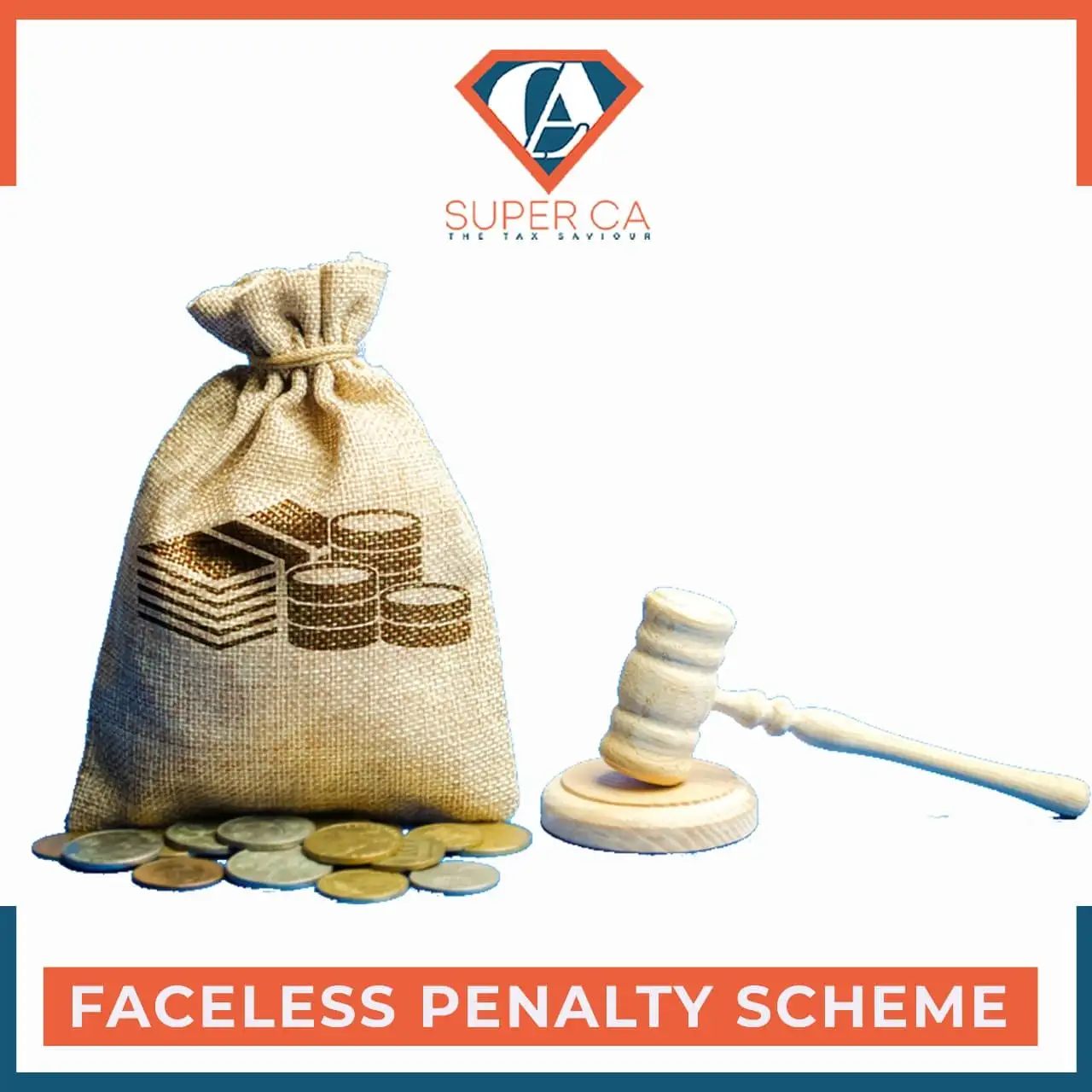Faceless Penalty Scheme, 2021
- Posted By SuperCA
- On 30 January

Faceless Penalty Scheme, 2021
Introduction
The Income Tax Department has introduced the Faceless Penalty Scheme for cases involving penalties recommended under the Faceless Assessment Program.
The Central Board of Direct Taxes (CBDT) has notified that it will set up faceless penalty centres, both at the national and regional levels.
As per the notification, the Income Tax Department will constitute the National Faceless Penalty Center, Regional Penalty Center (Regional Units), a penalty unit and a unit for execution of penalty proceedings.
The National Faceless Penalty Centre will do the work in a centralised manner, and also can order to re-examine and change the penalty imposed by its Regional Office. While the regional ones will facilitate the conduct of faceless proceedings and will be vested with the jurisdiction to impose penalty.
Scope of the Scheme
The penalty under this Scheme shall be imposed in respect of such territorial area, or persons or class of persons, or income or class of income or cases or class of cases, or penalties or class of penalties as may be specified by the Board and shall be effective from January 12, 2021
Faceless Penalty Centres
For the purpose to carry out penalty proceedings and to specify their respective jurisdiction, the board may set up -
➤ National Faceless Penalty Centre (NFPC)
• To facilitate the conduct of penalty proceedings in a centralised manner
• To have jurisdiction to dispose of penalty in accordance with the Faceless Penalty Scheme.
➤ Regional Faceless Penalty Centres (RFPC)
• To facilitate conduct of penalty proceedings and to have the jurisdiction to dispose the penalty in accordance with FPS
➤ Penalty Units (PU)
• To facilitate the conduct of faceless penalty proceedings
• To draft penalty orders, including identification of points or issues for imposition of penalty under the ITL.
• To seek any information or clarification on points or issue so identified.
• To provide the taxpayer an opportunity of being heard.
• To analyse the material furnished by the taxpayer and such other functions as may be required for the purposes of imposing penalty.
➤ Penalty Review Units. (PRU)
• To facilitate the conduct of faceless penalty proceedings.
• To review draft penalty order, including checking whether the relevant material evidence has been brought on record, whether the relevant points of fact and law have been duly incorporated in draft penalty order, whether the issues on which penalty is to be imposed have been discussed in the draft penalty order, whether the applicable judicial decisions have been considered and dealt with in the draft penalty order, checking arithmetical correctness of computation of penalty other such functions as may required for the purpose of review.
The notifications state that until specific units are set up under Faceless Penalty Scheme, the CBDT may direct certain units of Faceless Assessment Scheme, 2019 to perform the functions of various units under FPS. For instance, National Faceless Assessment Centre6 (NFAC) will act as NFPC, Regional Faceless Assessment Centre will act as RFPC, Assessment Unit will act as PU and Review Unit will act as PRU.
Mode of Communication
• All communication between Penalty Unit and Penalty Review Unit or with the taxpayer/any other person/National Faceless Assessment Centre (NFAC) / Income-Tax Authority with respect to information or documents or evidence or any other details as may be necessary for purpose of imposing penalty under the scheme, as the case may be, shall be exclusively through NFPC.
• Such communication shall be exclusively by electronic mode.
Procedure in Penalty -
• National Faceless Assessment Centre (NFAC) / Income-Tax Authority shall refer cases to NFPC in the prescribed form where:
- Penalty proceedings are initiated and show-cause notice is issued by ITA/NFAC; or
- Penalty proceedings are recommended by ITA/NFAC
• National Faceless Assessment Centre shall assign such cases to any Penalty Units in any RFPC in a randomized manner .
Preparation of draft penalty order
➤ Cases where initiation of penalty proceedings is recommended by ITA/NFAC:
• Penalty Unit is required to draft and provide a show-cause notice to be served on the taxpayer to NFPC if it agrees with the recommendations for levy of penalty. If it disagrees with such a recommendation, then it would be required to provide reasons for the same in writing to NFPC.
• On receipt of such show cause notice or reasons, NFPC, in cases where penalty is recommended to be initiated by PU, shall serve the show cause notice to the taxpayer, specifying the date and time for filing a response. In other cases, no penalty should be initiated by NFPC.
➤Cases where penalty proceedings are already initiated by ITA/NFAC.
• PU shall draft and provide a show cause notice as to why penalty should not be levied on the taxpayer to NFPC and NFPC shall serve the said show cause notice to the taxpayer, specifying the date and time for filing a response.
• The taxpayer shall file a response to the show cause notice to NFPC within the specified time or the extended time so granted on application by the taxpayer. If the response is filed by the taxpayer, NFPC shall send such a response to the concerned PU and if no response is filed by the taxpayer, NFPC shall inform the same to PU.
• PU then shall prepare a draft penalty order in writing after considering all relevant evidence/documents available on record, including any response filed by the taxpayer/any other person, any report furnished by ITA/NFAC for imposition or non-imposition of penalty.
• It shall forward the draft penalty order to NFPC.
Processing of Draft penalty order to Final penalty order
• NFPC shall examine the draft penalty order in accordance with risk management strategy specified by the CBDT and decide.
• To pass the penalty order as per draft order and serve thereon to the taxpayer. (In a case where imposition of penalty has been proposed)
• Not to impose penalty and, accordingly, intimate the taxpayer. (In a case where non-imposition of penalty has been proposed)
• To assign the draft penalty order to the Penalty Review Unit in a randomized manner for its review.
Review of Draft Penalty Order
Penalty Review Unit may review the Draft Penalty Order and decide to -
• Concur with the draft penalty order and intimate NFPC about such concurrence .
( In such a case, NFPC shall finalize the penalty order in case of imposition of penalty and served thereon to the taxpayer or intimate the taxpayer if no penalty is imposed. )
• Suggest necessary modification to the draft penalty order and send such suggestions to NFPC.
( In such a case, NFPC shall forward the suggestion to another PU (other than original PU) in a randomized manner)
➤ In such case the new Penalty Unit may :
• Follow the entire procedure as noted above and then pass revised draft order for imposition of penalty. ( If modifications are prejudicial to the interest of the taxpayer)
• Pass the revised draft order for imposition of penalty. ( If modifications are not prejudicial to the interest of the taxpayer)
• Propose non-imposition of penalty with reasons in writing.
➤ On receipt of draft order from PU (after review as the case may be), NFPC shall pass the final penalty order as per such draft and serve thereon to the taxpayer for imposition of penalty and send intimation to the taxpayer if no penalty is imposed.
• Without prejudice to the Faceless Penalty Scheme, NFPC may transfer the proceedings to ITA/NFAC having jurisdiction over the taxpayer with prior approval of the CBDT at any stage of the penalty proceedings, if considered necessary.
Conduct of Rectification Proceedings
• NFPC may amend any order passed under FPS for rectification of any mistake apparent from record upon application. Such rectification applications can be filed by a taxpayer/ PU/ PRU/ ITA/NFAC, as the case may be.
• NFPC shall assign rectification applications to any PU in a randomized manner. Such PU shall examine the rectification application and send a notice to the applicant through NFPC for granting an opportunity to show cause as to why rectification of mistake should not be carried out under the ITL.
• On receipt of such notice, the applicant shall furnish its response to NFPC within the specified time or extended time so granted. NFPC shall forward the said response to PU or inform PU if no response is received.
• PU shall, after taking into consideration such application and response, prepare a draft order for Rectification of mistake or Rejection of the application citing reasons thereof.
• Upon receipt of the draft order, NFPC shall finalize the order and communicate the same to Taxpayer/any other person and ITA/NFAC to take further actions under the ITL.
Appellate Proceedings Against order passed by NFPC
• An appeal against the penalty order passed by NFPC shall lie before the Commissioner of Income-tax (Appeals) having jurisdiction over Income Tax Authorities or National Faceless Appeal Centre, as the case may be.
Authentication of Electronic record
• An electronic record shall be authenticated by the originator, being NFPC, by affixing its digital signature or being the taxpayer or any other person, by affixing his/her digital signature or through electronic verification code.
Delivery of electronic record
Every notice or order or any other electronic communication under FPS shall be delivered to the taxpayer, by way of:
• Placing an authenticated copy thereof in the taxpayer’s registered account on designated portal
• Sending an authenticated copy thereof to the registered email address of the taxpayer or his/her authorized representative.
• Uploading an authenticated copy on the taxpayer’s mobile app and followed by a real time alert.
• The taxpayer shall file its responses to any notice or order or any other electronic communication under FPS through its registered account and the response shall be deemed to be authenticated once an acknowledgement is sent by NFPC.
• Time and place of dispatch and receipt of electronic record shall be determined in accordance with the provisions of Information Technology Act, 2000.
No personal appearance in the Centres or Units
• The taxpayer or its authorized representative or any other person is not required to appear personally for proceedings before any unit under FPS, though it can request for personal hearing so as to make oral submissions or present their case before the PU.
• On receipt of request for personal hearing, Chief Commissioner of Income-tax or Director General of Income-tax (in-charge of RFPC) may approve the request for personal hearing if it falls under specific circumstances.
Such personal hearing shall be conducted exclusively through video conferencing and in accordance with the procedure to be laid down by the CBDT
Benefits to the government and taxpayers
Tax experts say this is a great initiative. With its introduction, fines levied on any taxpayers will be investigated in several layers. An order to impose or eliminate the fine will then be issued. This will eliminate the fear of tax authorities among taxpayers and bring transparency in the entire tax system. The government also believes that this will make the tax system transparent and free the taxpayers from trouble and at the same time will help in curbing corruption and arbitrariness.
Under this, if there is any complaint of taxpayers, then its appeal will be sent to the officer selected in a random manner. Taxpayers will not have to visit any office for this. The direct and indirect income tax authorities have to make the tax system smooth and transparent through automation and technology. It is also helping income tax authorities to increase tax collection and catch tax evasion. At the same time, honest taxpayers will also get relief from this and they will not have to travel around the office.
Powers to specify format, mode, procedure and processes.
Powers are granted to NFPC to lay down standards, procedures and processes, including format, mode, procedure and processes for effective functioning of penalty proceedings under the Faceless Penalty Scheme, with prior approval of the CBDT.
Conclusion
The structure and functioning under Faceless Penalty Scheme are largely in line with the Faceless Assessment Scheme 2019. Further, till the various units are set up under FPS, units established under the Faceless Assessment Scheme 2019 may perform functions under FPS.
Though FPS is made effective from 12 January 2021, the CBDT is yet to notify the scope of the scheme. Additionally, it is not clear how ongoing penalty proceeding will be transitioned under FPS. Though this new digital era for conducting proceedings under the ITL may have some teething and practical problems, it is the need of the hour for the taxpayers and other stakeholders including tax professionals to adapt to and be convergent of online proceedings.





